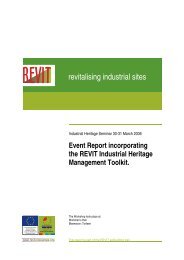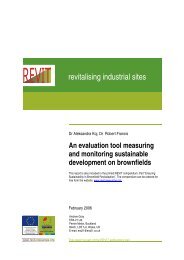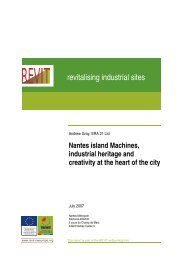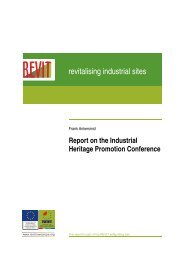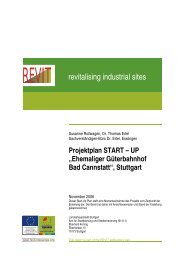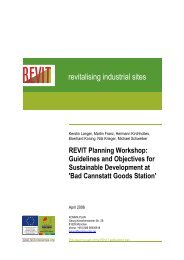REVIT Heritage Report.pdf
REVIT Heritage Report.pdf
REVIT Heritage Report.pdf
You also want an ePaper? Increase the reach of your titles
YUMPU automatically turns print PDFs into web optimized ePapers that Google loves.
Torfaen County Borough Council<br />
<strong>REVIT</strong>: A Review of the Conservation of Industrial <strong>Heritage</strong> Assets on Brownfield Sites<br />
depends on the recommendation or approval of the official architect, which is<br />
mandatory for planning permission and demolition permits issued by local<br />
authorities. The system is therefore based on a combination of state and local<br />
authority powers.<br />
3.7.36 The system of cultural heritage protection in France has a large number of<br />
public bodies operating in various specialised areas at national level and a<br />
regional level and with the authority of many bodies seemingly overlapping.<br />
3.8 Germany<br />
<strong>Heritage</strong> Bodies<br />
3.8.1 The Federal Republic of Germany (Bundesrepublik Deutschland or BRD) has<br />
no full ministry for culture heritage, although conservation and protection of<br />
cultural heritage has always been a main element of the Federal Government’s<br />
cultural policy and the Federal Government has launched several programmes<br />
dedicated to this purpose.<br />
3.8.2 The institutions involved in the protection of cultural heritage in Germany are<br />
the:<br />
• Permanent Conference of Ministers of Education and Culture of the<br />
Federal States (Ständige Konferenz der Kultusminister der Länder (KMK))<br />
• The German National Committee for Monument Protection (Deutsche<br />
Nationalkomitee für Denkmalschutz (DNK)<br />
3.8.3 The KMK deals with issues of general interest in relation to conservation and<br />
protection of cultural heritage and facilitate the co-ordination of organisational<br />
and administrative issues. In addition representatives of the respective state<br />
ministries sit on the relevant committee of the KMK.<br />
3.8.4 The DNK was established in 1973 and is responsible for promoting the<br />
interests of cultural heritage protection in a variety of political areas. In<br />
addition to engaging in a broad range of public relations activities, it provides<br />
comprehensive support on issues relating to the conservation and protection of<br />
cultural heritage and also plays a major role in shaping the general legal<br />
framework for cultural heritage conservation and protection and published<br />
“Promoting Sustainable Development and Architectural Culture” 2000.<br />
3.8.5 The national organisation of state archaeologists is called the<br />
Landesarchäologen and this is normally formed from the heads of the<br />
archaeological departments within the heritage management sections of the<br />
federal states. The Landesarchäologen acts as advisor to the federal<br />
ministers.<br />
3.8.6 Under the German constitution and federal system, many functions of<br />
government are controlled by the 16 individual federal states (Bundesländer).<br />
As a result the conservation and protection of the cultural heritage falls<br />
primarily within the remit of the federal states. They are responsible for<br />
adopting and executing laws governing the protection of the cultural heritage,<br />
together with the higher (administrative districts) and lower (districts and<br />
communes) cultural heritage authorities.<br />
3.8.7 The federal states also carry the main responsibility for providing conservation<br />
funds. However, substantial funds are also provided by the communes, the<br />
churches, foundations and private owners of monuments and historic<br />
buildings. Moreover, private owners of monuments and historic buildings<br />
0014021/JM/001 14




